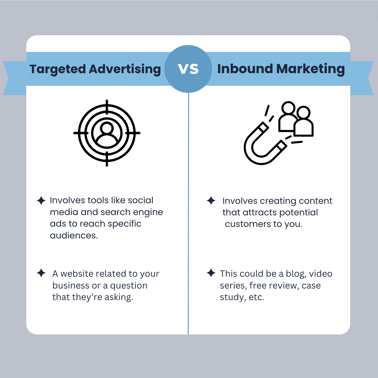As a marketer, you're constantly looking for ways to generate leads and grow your business. And while there are a variety of tactics you can use to accomplish this goal, cold calling and cold emailing are two techniques that have been around for decades and are still utilized today.
But in today's age of digital marketing, are these tactics still effective?
What are Cold Calls and Cold Emails?
First, let's define what we’re talking about. Cold calls and cold emails are made to a prospect that YOU have identified as a potential customer without any prior contact with your business. A truly cold lead is someone that you found that fits the criteria of an ideal customer.
Now, it is debatable whether someone who visited your website or liked a social post is a cold or a (luke) warm lead. But since they did not clearly request information, we will lean toward cold, unless they have clearly engaged consistently over a period of time (see our blog on lead scoring).
Do Cold Calls and Emails Still Work?
Now, onto the big question: do cold calls and emails still work? The answer is... it depends.
On the one hand, these techniques can be a quick way to reach a large number of people. They also have the potential to be more personal than other marketing methods, as you're directly contacting a person and can tailor your message accordingly.
Additionally, cold calling and emailing can help you get your foot in the door with companies or individuals who might not have otherwise considered your business but would benefit from your offerings (do remember that this is an assumption).
However, there are also a number of downsides. For one, they can be intrusive and annoying to the recipient. In fact, research has shown that 57% of people feel negatively about cold calls and 70% of people delete cold emails without even opening them. Additionally, there's a low response rate for cold emails, with one study showing that the average response rate is only 1%.
Is it worth it to your business to hopefully engage with 1% of your list while potentially angering the other 99%? That’s an important question to ask yourself. For a new business just starting out, there may not be any other option if your time and budget are tight. But it doesn’t come without risks — and too much of it will begin to define your brand's reputation.
So, What’s the Alternative?
Rather than relying on cold calls and emails, many marketers use targeted advertising and inbound marketing. Targeted advertising involves tools like social media and search engine ads to reach specific audiences. What makes this different from a cold contact is that you’re meeting your audience where they are, whether it’s a website related to your business or a question that they’re asking that you can help answer.
Inbound marketing, on the other hand, involves creating content that attracts potential customers to you. This could be a blog, video series, free review, case study, etc. Something that provides valuable information for your audience without asking for anything in return. That in turn positions you as a subject matter expert and keeps you top of mind when they’re ready to engage.
Ideally, a complementary mix of paid ads and organic inbound content with strategically used SEO keywords is used to address both situations.
The Combo Approach
Knowing that cold emails will probably happen at some point in the future for your business, I think it’s wise we also help you be as successful as possible under the circumstance. We saw that 70% of people delete cold emails without even opening them, but we have found one exception to the cold email problem to put you on the better side of that average statistic. Instead of reaching out and selling right away, you need to give something they value for free. Much like you do with inbound marketing, try to answer their questions before they ask them.
A free value-add could be in the form of a blog, video, case study, checklist, calendar, etc. Ask them a question like “Have you ever wondered about…” or “Do you ever struggle with…” and then tell them that you’ve helped others answer (or solve) that specific problem. Use the blog, video, etc. to solve their problem or answer their question for free or give them a tool to help them figure out their unique solution
By positioning yourself as a thought leader and as a helpful resource, you stand a better chance out standing out in the crowd by proving you’re helpful versus being just another salesperson.
There is No “One-Size-Fits-All” Solution
All of this being said, it's important to remember that there's no “one-size-fits-all” solution when it comes to marketing. What works for one business might not work for another.
In some cases, cold calling and emailing might still be valuable tools to have in your marketing arsenal when done thoughtfully. For example, think of a personalized phone call after researching a potential lead on LinkedIn versus power dialing a bought list of 1,000 leads.
If you're in the B2B industry, a well-crafted cold email directly to the CEO mentioning an event they were at or an article they were featured in can be a great way to get past the gatekeepers around them.
So, What's the Verdict?
While cold calling and emailing might not be the most effective or popular marketing tactics, they can still have value as part of an overall marketing plan. That being said, it's important to use these techniques sparingly and thoughtfully, and to always respect the recipient's time and privacy.
To summarize, here are a few key takeaways:
- Cold calling and emailing can be effective ways to reach a large number of people but they can also be annoying and intrusive to the recipient.
- Targeted advertising and inbound marketing are often more effective and less intrusive ways to generate leads.
- Cold calling and emailing can still have value in certain situations, particularly in B2B industries where relationships are key.
- Ultimately, the best marketing strategy is one that is tailored to your business's specific needs and goals.
As with any strategic marketing plan, it's important to evaluate your goals, target audience, and resources to determine whether cold calls and emails make sense. Strong marketing requires a plan, trial and error, and consistent optimization to grow your business.
For more great marketing tips, click here to subscribe to our blog notifications.





